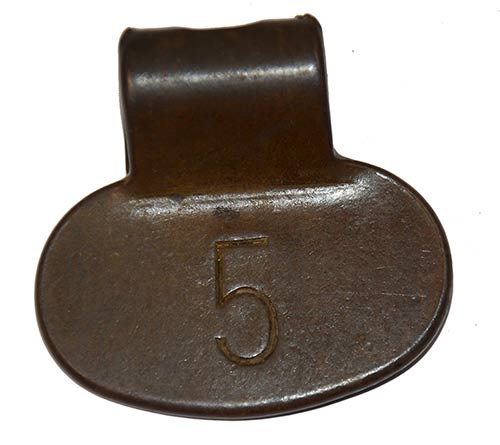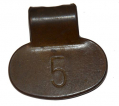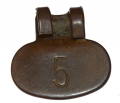site search
online catalog
BRASS BAGGAGE TAG ONCE OWNED BY J. HOWARD WERT

$85.00 SOLD
Quantity Available: None
Item Code: 224-784
This is a solid brass tag with the number 5 stamped on both sides. It is one and ¾ inches across and curved over top for attachment. Almost no patina. Recovered at Gettysburg.
At the time of the Gettysburg campaign, twenty-two year-old John Howard Wert was living at "Wolfe's Walk", a family farm located two and a half miles south of town on the Baltimore Pike. His forbears had moved into the Cumberland Valley following the Revolution, and by the early decades of the 19th century the Werts had become quite prosperous, and highly prominent in Adams County affairs. Young Wert himself a promising young man, recently graduated from Gettysburg's Pennsylvania College. Already embarked on a career in teaching he shared his family's abolitionist views, and, not surprisingly, had become a member of the local border defense unit, the Adams Rifles.
When the rebels headed north in early summer 1863, Wert and his Adams Rifle comrades were employed in scouting Lee's advance into Chambersburg. When the action moved to Gettysburg, Wert acted as an army guide throughout the fight. The men of Gen. John Reynolds' Union First Corps made their way through the streets of Gettysburg with his assistance. Later that day when Gen. Lee's Confederates forced the Union retreat through town, Wert once again provided his assistance in conducting them back to Cemetery Hill. He was also prevailed upon to guide soldiers to protect the Union's barely protected left flank at Little Round Top, and steered reinforcements to the Cemetery Ridge line on July 3 to assist in repelling the Confederate assault known as Pickett's Charge. It should be noted that J. Howard was not the only Wert to assist the Union army. Older family members had reviewed maps with Generals Slocum and Geary, pointing out important land formations.
By the time the armies marched away, the town of Gettysburg and adjacent fields had become - to borrow author Greg Coco's title phrase - "A Vast Sea of Misery." As the town moved into its hospital phase, the Werts joined other Gettysburgians in becoming caught up in caring for the wounded, their Aunt Katie in particular.
Meanwhile, J.H. Wert continued to perform a variety of humanitarian tasks, which included guiding visitors around the battlefield in search of the graves of fallen relatives. He seems to have been constantly out on field from July 5th on, observing and taking note of the devastation on all sides, including, of course, the bloated and decomposing. Wert's recollections from late summer 1863 figure prominently in A STRANGE AND BLIGHTED LAND, author Greg Coco's highly regarded study of the Gettysburg aftermath. Most telling is Wert's Culp's Hill sighting of the mangled and shredded remains of a soldier laying on the flat rock where the 29th Pennsylvania regiment presently sits. Among the bone and body part fragments were broken shards of a daguerreotype photo, which had prompted Wert to wonder "…what aching heart of wife, or mother, or child in distant home, they represented."
Wert retained these Culp's Hill photo fragments, thereafter preserving those relics or souvenirs he recovered or had given to him, becoming a custodian of the detritus of the battle. This practice dovetailed with the family habit of preserving relics connected with the anti-slave "Underground Railroad". What was unusual was the conscientious and systematic manner in which Wert went about tagging and cataloguing his specimens. He continued these Gettysburg battle relic explorations well into 1864, the year in which he became a soldier himself, enlisting that September as a Sergeant in Co. "G", 209th PA. Infy.
The 209th PA served at the Bermuda One Hundred through November 1864, and then in the Petersburg trenches through remainder of the war, taking part in the final pursuit leading to Lee's surrender at Appomattox. Mustered out May 31, 1865, the regiment had lost 19 men killed and wounded, and 20 by disease. Their sergeant from Gettysburg had been promoted to 1st Sergeant in January 1865 and commissioned 2nd Lieutenant in February.
Returning home, Wert began a career as a school administrator, becoming principal of Gettysburg High School in 1866, and then superintendent of the Adams County school system in 1869. He also became a Grand Army of the Republic activist and was one of the founders of the Corporal Skelly Post, Number 9, G.A.R. Then in the mid-seventies he accepted an appointment as principal of Harrisburg High School, and removed to the capital city, where he became associated with G.A.R. Post 58.
Through the turn of century and beyond, Wert corresponded with a number of Gettysburg notables, including famed mapmaker John Batchelder. He entertained others such as General Dan Sickles during reunion visits to Gettysburg. Wert lectured widely and wrote a number of books, including A COMPLETE HAND-BOOK OF THE MONUMENTS AND INDICATION AS AND GUIDE TO THE POSITIONS OF THE GETTYSBURG BATTLEFIELD.
A much honored and revered Gettysburg resident, J. Howard Wert passed away in 1920. [ff/jp] [ph:L]
~~~~~~~~~~~~~~~~~~~~~~~~~~~~~~~~~~~
THIS ITEM, AS WITH ALL OTHER ITEMS AVAILABLE ON OUR WEB SITE,
MAY BE PURCHASED THROUGH OUR LAYAWAY PROGRAM.
CLICK HERE FOR OUR POLICIES AND TERMS.
THANK YOU!
Inquire About BRASS BAGGAGE TAG ONCE OWNED BY J. HOWARD WERT
For inquiries, please email us at [email protected]
Most Popular
Historical Firearms Stolen From The National Civil War Museum In Harrisburg, Pa »
Theft From Gravesite Of Gen. John Reynolds »
Selection Of Unframed Prints By Don Troiani »
Fine Condition Brass Infantry Bugle Insignia »
British Imported, Confederate Used Bayonet »
Scarce New Model 1865 Sharps Still In Percussion Near Factory New »
featured item
CONFEDERATE OFFICER’S UNIFORM GROUP OF LIEUTENANT, CAPTAIN AND MAJOR HUGH MORTIMER NELSON: 1st VA CAVALRY, 6th VA CAVALRY, ADC TO EWELL, WIA GAINES MILL
This wonderful Confederate officer’s grouping came directly out of the family, from the officer’s great-great-grandson in 1995, and went into the collection of esteemed artist, collector and historian Don Troiani, who pictured parts of it in his… (153-09). Learn More »
site search
Upcoming Events
May 16 - 18: N-SSA Spring Nationals, Fort Shenandoah, Winchester, VA Learn More »




